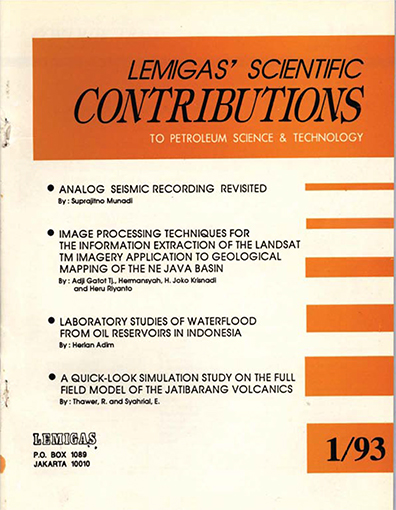LABORATORY STUDIES OF WATERFLOOD FROM OIL RESERVOIRS IN INDONESIA
DOI:
https://doi.org/10.29017/SCOG.16.1.1110Keywords:
Laboratory, Waterflood, Oil ReservoirsAbstract
The continual shortage of domestic crude oil requires optimum oil and gas conservation practices to ensure maximum recovery from the reservoirs. Oil production from reservoirs by natural (primary) drive mechanisms is often an inefficient process which may leave considerably more “residual†oil trapped behind the reservoirs than can be produced.
References
Abranessa, A., “The influence of fluid viscocity, interfacial tension, and flow velocity on residual oil saturation left by waterfloodâ€, Paper nuber SPE 5050.
Cralg, F.F. Jr., 1979, “The reservoir engineering aspects of waterfloodingâ€, Special Research Associate, Amoco Production Company
McKay, B.A., 1974, “Laboratory Studies of Gas Displacement from Sandstone reservoir haaving strong water driveâ€, Burcau of Mineral Resources, The APEA Journal, Canberra
Rapoport and Leas, 1975, “Properties of Linier Waterfloodâ€, AIME Trans, Vol. 198
Sarmlento, R., 1973, “Advance reservoir geologyâ€, Oil and Gas Consultantes International, Inc. Tulsa,Oklahoma, USA
Downloads
Issue
Section
License
Copyright (c) 1970 SCIENTIFIC CONTRIBUTIONS OIL AND GAS (SCOG)

This work is licensed under a Creative Commons Attribution 4.0 International License.
Authors are free to Share — copy and redistribute the material in any medium or format for any purpose, even commercially Adapt — remix, transform, and build upon the material for any purpose, even commercially.
The licensor cannot revoke these freedoms as long as you follow the license terms, under the following terms Attribution — You must give appropriate credit , provide a link to the license, and indicate if changes were made . You may do so in any reasonable manner, but not in any way that suggests the licensor endorses you or your use.
No additional restrictions — You may not apply legal terms or technological measures that legally restrict others from doing anything the license permits.














